Safely recirculating the air from your dust collector has never been easier
October 26, 2022
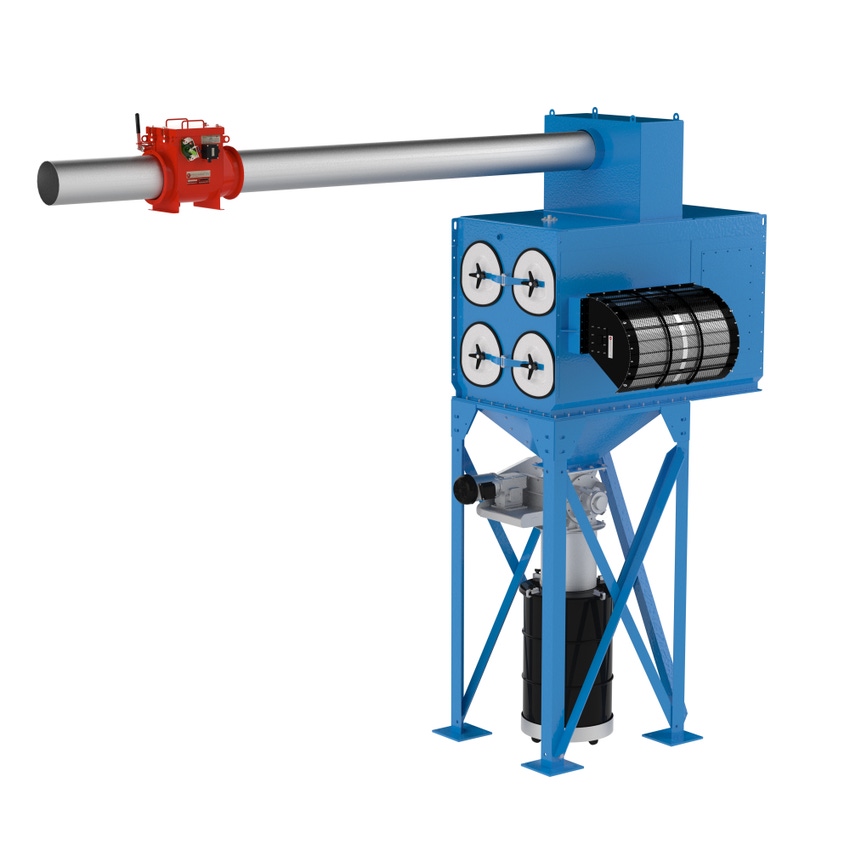
Jason Krbec, sales engineering manager, CV Technology
Plants in various manufacturing sectors must handle, transport, process, and store dry bulk solid particulate materials like powders, granules, agglomerates, and fibrous materials that can easily generate dust. For example, a cereal manufacturer may require various recipe ingredients to be mixed forming a dust cloud as material is added; a biomass company may have to transport and store a pelletized wood material that generates dust as the pellets are conveyed because of the friction a mass of pellets can create during transfer. Or a chemical company may use evaporation to remove water from a solution to improve a material’s characteristics for further processing or other purposes, producing a dry, combustible powder.
No matter what type of dry bulk processing a plant is involved in, dust generated in a piece of equipment or present in a plant area can pose a fire and explosion hazard to operators, equipment, and even the surrounding community.
Controlling Dust at Your Plant
One important piece of equipment that helps plants manage combustible dust hazards is the air-material separator (AMS), which often takes the form of a dust collector containing filters that separate air and dust (see Figure 1). A typical dust collector works when dust-laden air from processes or from cleaning activity is drawn to the inlet of the dust collector via a pneumatic conveying pipeline. The dust-laden air then travels through filters within the collector’s housing. This is where the dust and air are separated: the filter media traps the dust as the dust-laden air moves through the media. The dust remains in the filters until cleaning when it then drops down to the bottom of the collector. This process typically means that dust may accumulate in the filter media or at the bottom of the dust collector, while the now clean air is directed to an outlet line on the dust collector, either to be released outdoors to the atmosphere or recirculated and reused in the plant.
Choosing to recirculate air in a plant has various benefits, but safely recirculating air has requirements in North America that are specified by the National Fire Protection Association (NFPA). This organization created standard NFPA 652, Standard on the Fundamentals of Combustible Dust to share best practices for dealing with combustible dust, including guidance on recirculation. Other commodity-specific standards may also need to be referenced, depending on your specific application because they outline particular rules for agriculture and food (NFPA 61), wood and wood processing (NFPA 664), and combustible particulate solids (NFPA 654). The NFPA standards identify eight criteria to follow for safe air recirculation. One of the most important being that recirculation requires that a deflagration originating in the dust collector (or AMS) cannot transmit the flame and pressure effects of such a deflagration to the connected facility or occupants. Meaning that the clean air intended for recirculation coming from the dust collector must be adequately protected with isolation equipment. Some other criteria are ensuring that:
hazardous gases and vapors are below exposure limits
combustible solids are below the industrial hygiene exposure limits
the appropriate oxygen concentration in the recycled air stream is achieved
the dust collector cannot allow deflagration flame and pressure to reach downstream equipment
the dust collector cannot allow smoke and flame from a fire to reach downstream equipment
the recirculation system includes a method to detect AMS malfunctions
the building or building compartment to which the recycled air is returned meets the housekeeping and electrical classification requirements for which they were designed
recirculation-related air ducts are inspected and cleaned regularly
The benefits of recirculating dust collector air in a plant are many. Not only can it provide important energy cost savings, but it has other unique benefits that might get overlooked in the effort to simply save money on HVAC costs by reusing treated air. Recirculation benefits include energy cost savings, regulatory advantages, and positive neighbor relations.
Energy Cost Savings
Dust collectors that recirculate treated (either heated or cooled) air back through a plant can eliminate the expense related to treating that air. With high energy costs a concern for many industries, implementing a retrofit or planning to incorporate air recirculation in a new process can make financial sense. As more companies implement sustainability plans, safely recirculating plant air is a great way to show that your company has made efforts to save energy and improve sustainability while positively impacting your budget.
Regulatory Advantages
The air that enters a dust collector for filtration is contaminated by the dust it contains. The dust may be from a food product, a chemical process, or have come from one of many other processes. No matter the source, this contaminated air must be properly permitted when released outside a plant to current regulatory standards, which can include applying for and keeping air permits updated with a government entity. In contrast, containing the air inside your facility and equipment requires meeting different indoor air quality standards without applying for complex, time-consuming air permits. Some indoor air quality standards may require personal monitors to ensure worker safety, but the compliance process is often simpler to complete versus what’s required to gain an air permit allowing outdoor emissions. Check with your local agencies to find out if permits are required for indoor or outdoor releases to know whether recirculation offers this benefit for your facility.
Positive Neighbor Relations
Part of being a business in a community means being a good neighbor. If you can avoid releasing contaminated air to the outdoor environment, this can avoid the issues whether perceived or real that can arise with outdoor dust collector system and exhaust stacks that may cause community concern and complaints. By safely recirculating air, there is an opportunity to avoid these conflicts with neighboring businesses and residents while reaping the other benefits of an air recirculation system.
Dust Collection’s Role in Plant Safety
Dust collectors serve an important safety role in most plants handling combustible dusts that come from bulk solid materials. To understand how recirculation can potentially be implemented to your advantage also means understanding the important fire and explosion prevention steps that must be taken to isolate the combustible dust inside a dust collection system and allow safe recirculation. Remember that combustible dust can pose a safety risk to your equipment, workers, facility, and the surrounding community. That means reducing combustible dust hazards in any process is important.
Many operators and plant personnel are already familiar with the three components that create a fire: fuel, ignition, and oxygen. Implementing fire protection in a plant prevents damage and reduces risks to workers and should play a part in any plant’s safety management plan. When it comes to considering dust collector risk factors, remember that if you add two more elements to the fire triangle, the risk and potential for not only plant damage and destruction, but also loss of life and injury to workers is increased. What are those two elements? Dispersion and confinement--which are two elements that a dust collector creates the perfect environment for while in operation. For example, dust dispersion happens whenever a pulse-jet dust collector’s filters are cleaned using compressed air that’s pulsed onto the filters to dislodge the dust. Confinement is created by the dust collector’s housing that serves to contain the dust and keep it away from workers and processes. As shown in Figure 2, once you have the five elements, you can see that the explosion pentagon has been formed and the potential is present for a dangerous explosion incident.
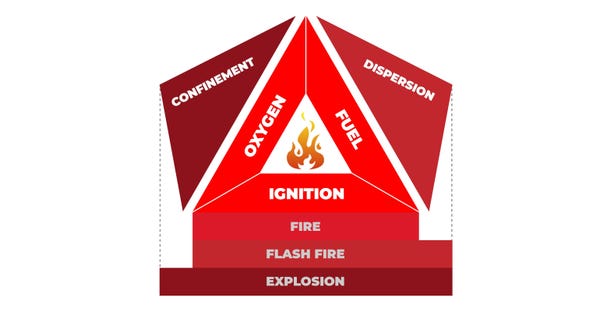
The typical filtration-style dust collector reduces the risk posed in plant areas, in processing equipment, and to the operators it is designed to protect. The dust collector is designed to bear the brunt of a deflagration vent, but the higher risk of a deflagration incident is essentially moved from one plant location to the dust collector itself. The benefit to this arrangement is that there are ways to protect dust collectors and prevent and mitigate explosions. Concentrating the greater portion of risk to one location means that resources to combat those risks can also be focused there instead of in multiple locations. The improvements to process safety regarding dust collectors have grown in the modern era through research, testing, and new safety solutions being designed and brought to market by specialist companies.
Protection Options for Dust Collection Systems
There are three main aspects to protecting a dust collector: protecting the upstream equipment and areas (dirty-air side), protecting the dust collector itself, and protecting the downstream equipment and areas (clean-air side). Protecting the clean-air side is the focus we’ll cover in depth here because that’s the portion of the dust collection system with additional NFPA requirements to make recirculation possible. However, let’s first cover some basic protection solutions for the dirty-air side and the dust collector vessel.
First, for the dirty-air side, protection options such as a back flap valve and chemical isolation device can be used. Next, the dust collector vessel has different requirements, so it can be protected by an explosion vent, flameless vent, or chemical suppression device. In Figure 3, you can see one example of a protected dust collector with a back flap valve and a flameless vent.
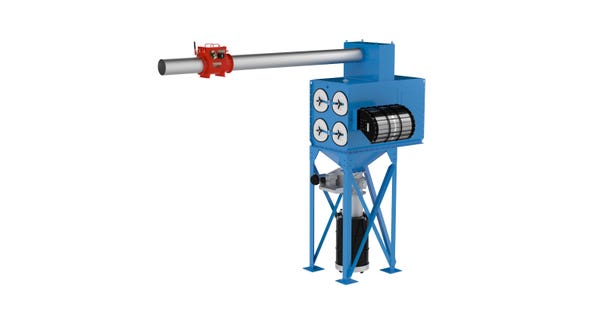
Finally, protection in terms of air recycling and recirculation on the clean-air side can be protected using four main solutions. These solutions isolate the dust collector’s clean-air line that’s connected to a plant area or process and include a flame arresting valve, a back flap valve, a float valve, or a chemical isolation device. The advantages and disadvantages of each option are important to consider, so the following is a guide to help in selecting the appropriate solution for your application. Note that all options meet NFPA requirements.
Option 1: Flame Arresting Valve
A flame arresting valve (see Figure 4) can be installed in the clean-air line and offers passive isolation protection of the line for situations where venting to safe areas isn’t possible or for air recycling and venting into a facility or for mill intakes.
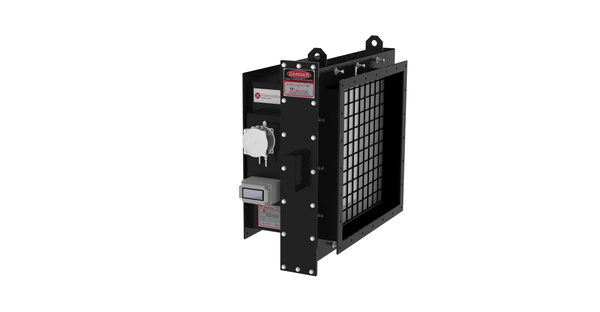
Advantages include having a field-replaceable mesh cartridge, a pressure differential signal when mesh is dirty, an output if flame is sensed, low maintenance, and economical.
Disadvantage is that these valves can typically only be used with organic materials (no metal dusts).
Option 2: Back Flap Valve
A back flap valve (see Figure 5) can be installed in the clean air line and provides passive isolation protection via a circular metal flap within the valve that slams shut and locks during a deflagration, closing off the pipeline. The valve’s flap is kept open mechanically during normal operation for low pressure drop across the valve.
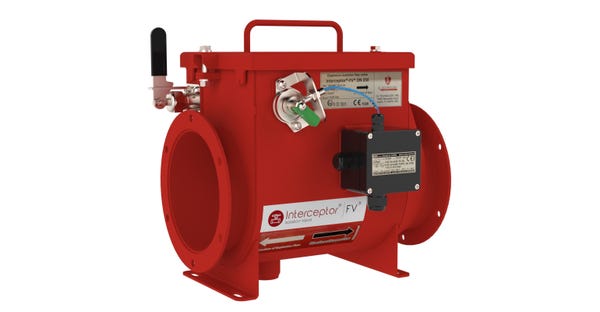
Advantages include varied installation options, including horizontally and in some cases vertically, the ability to handle dusty materials, and the capability for use with metal dust applications if properly certified.
Disadvantages include that not all flap valves have been tested to real-world standards, so ensure you choose a company that has tested to EN 16447 standards and beyond; that some flap valves may not include a mechanical means to ensure air flow during normal operations, producing unnecessary pressure drop across the valve; installation limits for number of elbows between the dust collector and valve, depending on manufacturer’s certification; and limited valve sizes for larger line diameters.
Option 3: Float Valve
A float valve (see Figure 6) can be installed in the clean-air line and provides passive isolation protection for demanding applications. The valve features a floating metal disc that pushes against the valve housing and closes off the pipeline in reaction to a pressure wave from a deflagration.

Advantages include an ability to handle high-KSt applications and metal dusts; robust construction for even combustible gases and hybrid mixtures; a sensor to indicate valve activation, which can be reset and maintained in-line; and the availability of additional models with clean-in-place, high-temperature, and high-pressure capabilities.
Disadvantages include an inability to handle high dust loading applications and abrasive dusts and a higher initial cost to account for the valve’s robust construction and ability to be reused.
Option 4: Chemical Isolation Device
A chemical isolation device (see Figure 7)) can be installed on a clean-air line and provides active isolation protection for pipelines using pressurized cylinders that rapidly release suppressant (usually sodium bicarbonate), creating a homogenous cloud to extinguish flame and stop a pressure wave. The device depends upon flame detection equipment to activate.

Advantages include the availability of various sizes to accommodate different line sizes; lock-out/tag-out capability for inspection, repair, and maintenance; and installation orientation flexibility.
Disadvantages include that the chemical suppressant must be cleaned out if device activation occurs and the sodium bicarbonate is released into ductwork; a more advanced controller is required for operation; and more routine maintenance is required.
Conclusion
With multiple protection options available, safely recirculating the air from your dust collector has never been easier. Consider your plant’s safety needs and whether recirculation can be part of your facility to achieve cost savings and other benefits for your process in the long term.
Jason Krbec is sales engineering manager, CV Technology (Jupiter, FL). For more information, call 561-694-9588 or visit www.cvtechnology.com.
You May Also Like


